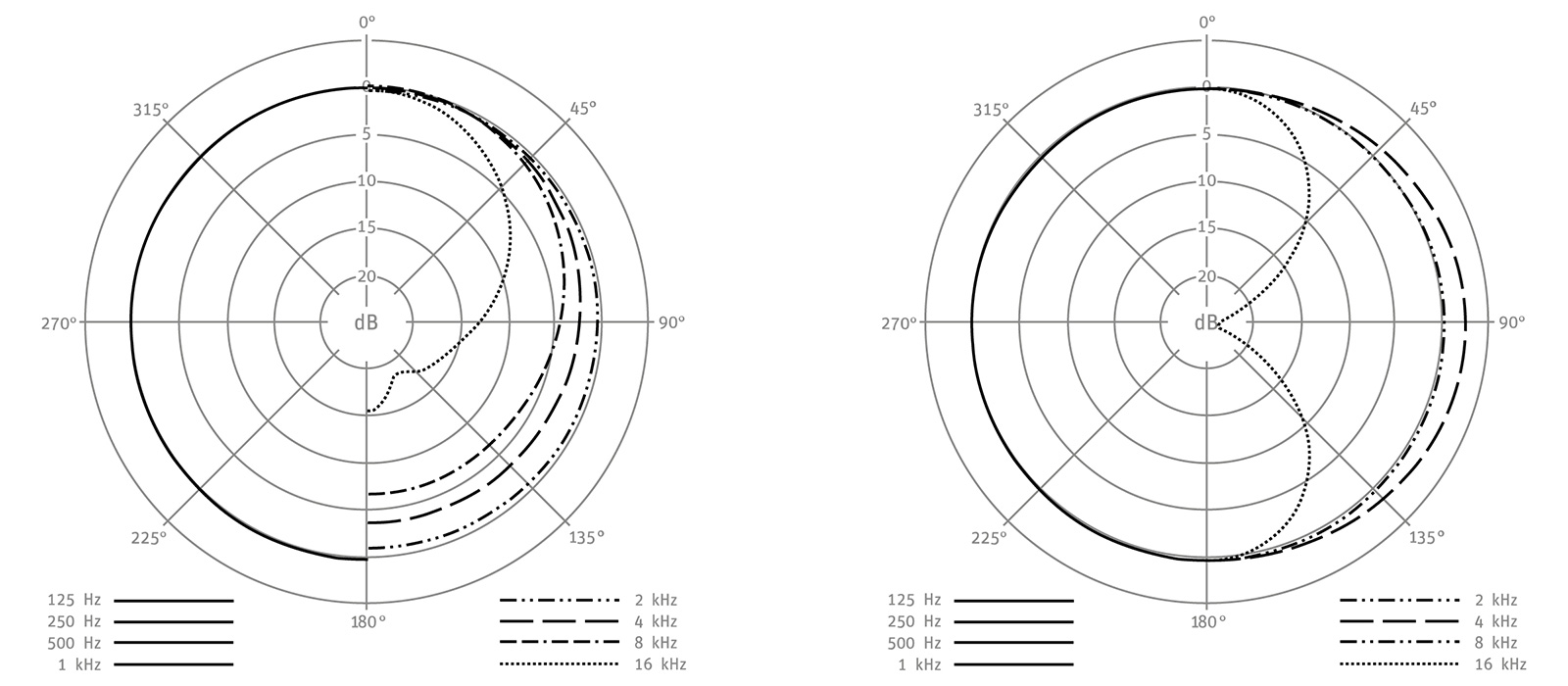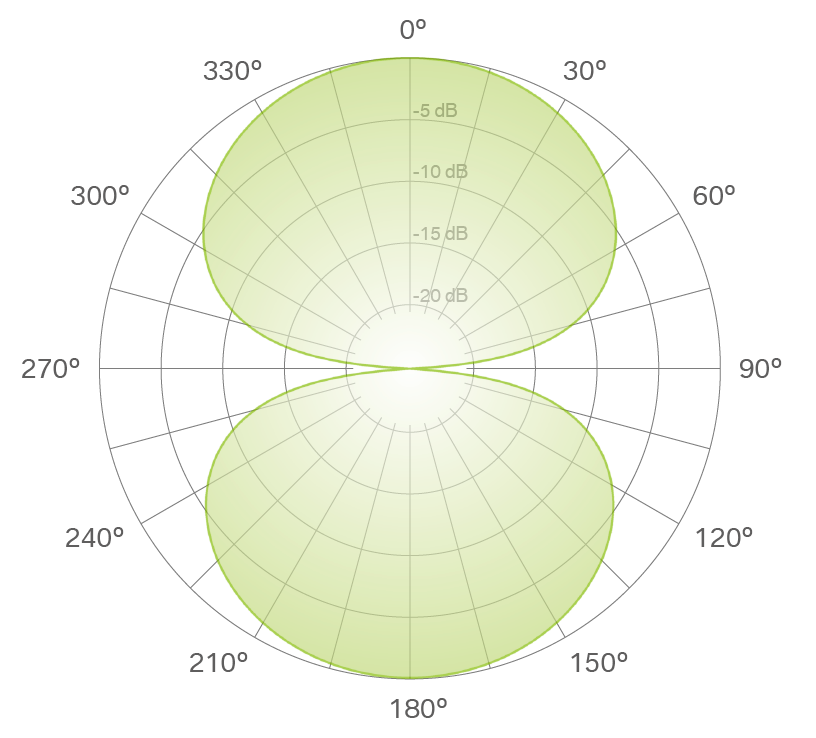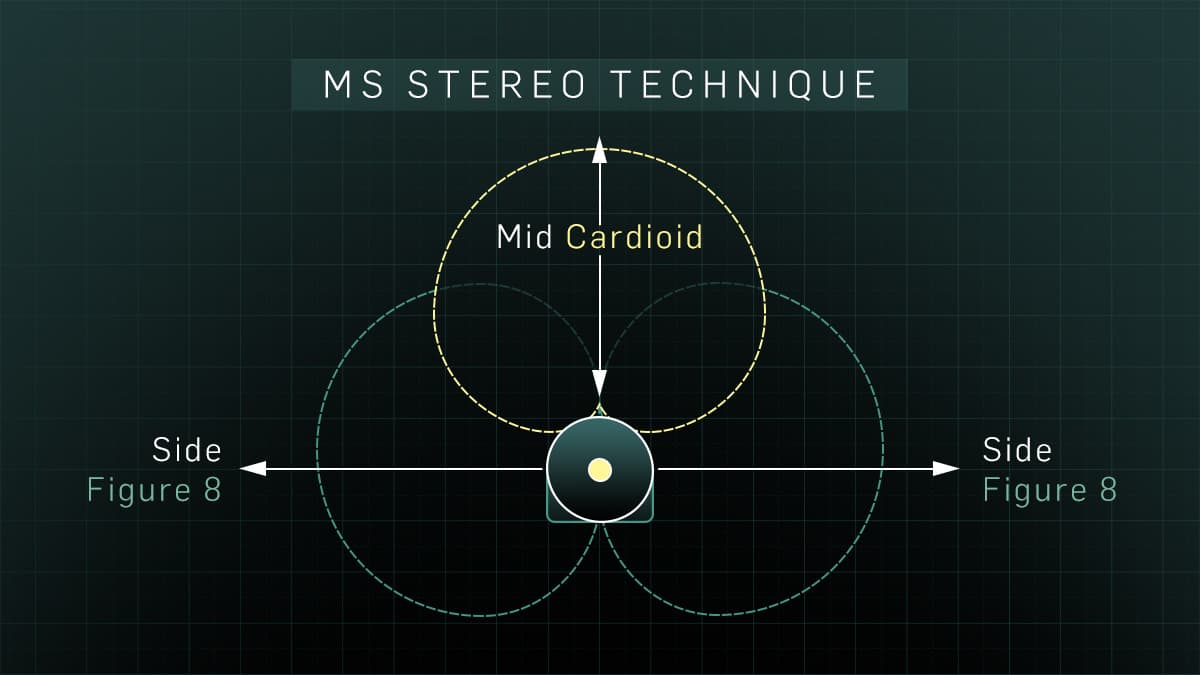The evolution of studio microphone directivity
Views : 12249
Update time : 2021-10-15 14:43:36
Today, we know that professional studio microphones have many different directivity-the most widely used cardioid direction is suitable for vocals and various musical instruments, while omnidirectional is an irreplaceable choice for room microphones and string main microphones. In order to meet our needs for recording different sound sources, many microphones are designed to switch between multiple directivity. But when the microphone was invented, there was no such directivity as we know it today. Now let us follow the historical track of the microphone to understand the evolution of the directivity of the microphone.

In the early days when microphones were invented, no matter what type they were, they were all omnidirectional. Omnidirectional microphones have basically the same sensitivity to sounds from all directions.

Between 1876 and 1878-David Edward Hughes, Emile Berliner and Thomas Edison invented the carbon microphone. In the 2nd and 30th of the 20th century, Western Electronic's carbon microphone became the most representative product of that era.
(Why don’t we see this kind of microphone now? The advantage of the carbon microphone is that the output voltage is high and no additional transformer is needed. The disadvantage is also very obvious-the frequency range that can be picked up is very narrow. I believe everyone is in some precious history. I heard this sound in recordings. Therefore, after the invention of dynamic microphones and condenser microphones, carbon microphones gradually disappeared from the recording studio)
1916-The condenser microphone was invented by Edward C. Wente, a researcher at Westen Electronic. In 1928, Neumann introduced a mass-produced condenser microphone CMV3, which was sold by TELEFUKEN.
1931-Westen Electronic introduced a mass-produced dynamic microphone 618A. In fact, dynamic microphones were theoretically invented in the 1870s, but since transformers and mature permanent magnets had not yet been invented at that time, this led to the fact that a truly usable dynamic microphone did not appear until 1931.
The earliest microphones were all omnidirectional. Whether it was a carbon particle, condenser or dynamic microphone, these microphones had a closed cavity behind the diaphragm, and sound waves from any direction could only reach the front of the diaphragm. Therefore, there is no directionality.
Omni / Omnidirectional microphone Practical Tip
Practical Tip 1: When to use an omnidirectional microphone?
Record room sounds: such as room microphones used as drum kits
Record a wide range of sound sources: such as orchestras, choirs, etc.
Practical Tip 2: Stereo recording based on omnidirectional
AB stereo-consists of 2 omnidirectional microphones with a spacing of usually 50cm. Can provide a wide, relaxed sound field and natural frequency response. It is suitable for sound sources with ideal acoustic conditions in the room or a wide range of sound sources. It is the most common stereo main microphone for string music recording in studios and orchestral music in concert halls.

Practical Tip 3: The directionality of omnidirectional
Any omnidirectional microphone will show a certain degree of directivity at high frequencies. This is because the high frequency has a shorter wavelength and it is more difficult to bypass the microphone tip to reach the diaphragm on the other side. The larger the diaphragm size, the lower the frequency of directivity. In addition, single-diaphragm omnidirectional microphones and dual-diaphragm omnidirectional microphones exhibit different directivity at high frequencies. The directionality of a single diaphragm at high frequencies tends to be cardioid, while a double diaphragm tends to be more toward a figure of eight.

So, please point the spindle of the omnidirectional microphone to your main sound source!
 1924-Figure 8 / Figure 8 pointing,also called Bidirectional. The sound from the front and back of the microphone has the same output size, while the sound from the left and right sides is very small, forming a directivity pattern like the number 8.
1924-Figure 8 / Figure 8 pointing,also called Bidirectional. The sound from the front and back of the microphone has the same output size, while the sound from the left and right sides is very small, forming a directivity pattern like the number 8.
1924-The ribbon microphone was invented by Walter Hans Schottky and Erwin Gerlach. Like the early dynamic microphones, due to the late arrival of reliable permanent magnets, it failed to reach the masses in that era. In 1931, Harry F. Olson of RCA designed a mass-produced ribbon microphone PB31, and a few months later launched an improved version of PB31-the cross-era RCA 44.
The front and back sides of the ribbon microphone diaphragm will receive sound waves, and the sound on the left and right sides will cancel out on the front and back sides of the diaphragm, thus forming a figure of eight directivity.
Practical Tip 1: When to use a figure-of-eight microphone?
When using ribbon microphones-In most cases, we choose figure-of-eight microphones not because we need this directivity, but because we need to use ribbon microphones, and almost all ribbon microphones are figure-of-eight. Many sound engineers like to use ribbon microphones for OverHead and guitar amps.

Practical Tip 2: Stereo recording based on figure eight
M/S stereo-consists of 2 microphones with the diaphragms as close as possible, the center-shaped M microphone is placed forward, and the figure-eight S microphone is placed sideways. The signals of the two microphones can be superimposed in the forward and reverse directions to get the left and right channel stereo (many M/S plug-ins can help you easily do this). The advantage of M/S is that it can adjust the stereo width by adjusting the level ratio of cardioid and figure-8 microphones, which is very useful when recording drum kits and acoustic guitars.

Blumlein stereo-consists of two figure-eight microphones with an angle of 90°, and the microphone diaphragm should be as close as possible. Blumlein can get a clear positioning similar to X/Y stereo, and at the same time get a very realistic sound field feeling. Note that although the sound pickup range of Blumlein is 360°, the correct stereo positioning can be obtained only when the sound source is in the area of ±45° in the front and 135°-225° in the rear (viewing from the microphone diaphragm). The areas on both sides, left and right are inverted

Practical tip 3: Use M/S stereo to record vocals
As long as you properly adjust the ratio of the cardioid pointing to the figure-8 pointing, you can get a concentrated but natural stereo Vocal

Part3:1932-Cardioid / Heart Pointing
 The word Cardioid comes from the Greek καρδιά-heart. The output of the sound from the front of the microphone will be significantly greater than the output of the sound from the rear. The polar coordinate pattern looks like a "heart", which is the most widely used directivity today.
The word Cardioid comes from the Greek καρδιά-heart. The output of the sound from the front of the microphone will be significantly greater than the output of the sound from the rear. The polar coordinate pattern looks like a "heart", which is the most widely used directivity today.
In 1932-Nuemann introduced an improved version of CMV3-CMV3A, which can be regarded as the predecessor of the multi-directional microphone, because it can replace the polar head to achieve different directivity. Nuemann has designed several poles with different orientations for it, including the omnidirectional M9 pole, the 8-shaped M8 pole, and the most special one is the M7 pole. M7 combines an omnidirectional condenser pole head and a figure-eight aluminum tape pole head together to realize a cardioid microphone in the world.
Subsequently, because of the good practicability of cardioid microphones, microphone manufacturers began to develop cardioid pointing microphones. RCA and Shure adopt the method of opening holes in the pole cavity, so that the sound waves in the front and rear directions of the microphone reach both sides of the diaphragm at different times, thereby realizing a cardioid microphone with a single diaphragm. The Unidyne Model 55 in 1939 is a single-diaphragm cardioid microphone in the world. Now, almost all dynamic microphones are using this mode. It is also very simple to change this kind of microphone back to omnidirectional-just hold the main microphone head (mistake!)
Practical Tip 1: When to use cardioid microphones?
As the most widely used type of pointing, cardioid pointing is suitable for almost all kinds of human voices and musical instruments. There are a few things that require simple attention, such as the proximity effect. But figuring out the direction of the pickup is the most important...

Practical Tip 2: Stereo recording based on cardioid
A/B stereo-A/B usually uses omnidirectional microphones, but cardioid microphones can also be an option when using smaller spacing. If you want to make your acoustic instrument sound more natural and active, you can try this way of recording.
X/Y stereo-consists of 2 cardioid microphones with an angle of 90°. The diaphragms of the microphones should be as close as possible. Can bring very clear and stable stereo positioning, is a commonly used stereo recording method

ORTF stereo-consists of 2 cardioid microphones with an angle of 110°, and the diaphragm spacing is 17cm. This setting simulates the state of the human ear, has a clearer positioning than A/B, and a wider sound field than X/Y.
Practical Tip 3 Use a paired microphone to record stereo

When recording stereo, we better use the microphone paired by the manufacturer. The measurements of these microphones have been strictly matched to ensure that the frequency responses of the two microphones are as consistent as possible.
Part4:1936-Mutil-Patterns / Multidirectional microphone
The directivity of the microphone can be switched between omnidirectional, cardioid, figure 8 or more

1936-Von Braummuhl and Weber invented the dual-diaphragm condenser pole head. The microphone pole head is designed with two front and rear diaphragms, and holes are opened on the polar plates of the two diaphragms, so that both the front and rear diaphragms present a cardioid orientation. By combining the signals of the two diaphragms with different amplitudes and phases, it is possible to switch from omnidirectional, figure-eight to cardioid and more directions.
You can see the plate with small holes behind the diaphragm

Through this combination mode, more directivity can be evolved, such as the wide-Cardioid between the omnidirectional and the cardioid, and the super-cardioid between the cardioid and the figure-8. (Super-Cardioid)




Practical Tip 1: When to use supercardioid pointing?
Using supercardioid in Snare and Tom can reduce crosstalk from other Snare or Tom. On the stage, it is also a common way to use supercardioid microphones for guitar speakers.
Practical Tip 2: When to use wide heart-shaped pointing?
Used to record a set of acoustic instruments, such as a string quartet. The low close-talking effect and off-axis coloring enable the wide-cardioid microphone to provide a certain degree of isolation while obtaining a very natural sound.
Since then, the directional evolution of microphones has fallen into a long period of stagnation. To this day, most of the microphones we use in recording studios still use these directivity modes...
Part6:2016-Microphone that can change directivity after recording
The directivity of microphones finally ushered in a new leap after 80 years. Could this be the high-quality form of multi-directional studio microphones?

Practical Tip 1: When do I need to adjust the directivity after recording?
Adjust the tone-different directivity will bring different tone, which is the same on any sound source, but it is especially obvious and practical on the guitar amp.
Adjust the sense of space-increase/decrease the real sense of space for your vocals and musical instruments. When used as a room microphone for a drum kit, this kind of spatial plasticity is very useful for mixing engineers.
Adjust crosstalk-We may sometimes encounter such a problem when we find too many Clicks in the vocal microphone, or too many snare drums in the ground-through microphone. By making the microphone directivity sharper, this situation can be greatly improved. During the simultaneous recording, you may also find that adjusting the microphone directivity wider can help increase the fusion of the instrument and the overall sense of the band.
Directional Automation-Modern technology has given us more space and possibilities for creation. How to automate the directionality? Who can say no?
Practical Tip 2: When to use the stereo output of a single microphone?
The stereo output of the dual-diaphragm microphone is actually two cardioid microphones with an angle of 180°. One of the most typical use methods is-placed sideways above the drummer's head as a stereo OverHead. Or is it a male and female duet? ASMR seems to be good too?
Whatever... Any method you think of is worth trying.

Part 1:Omni / Omnidirectional microphone history
1876-Omni / OmnidirectionalIn the early days when microphones were invented, no matter what type they were, they were all omnidirectional. Omnidirectional microphones have basically the same sensitivity to sounds from all directions.

Between 1876 and 1878-David Edward Hughes, Emile Berliner and Thomas Edison invented the carbon microphone. In the 2nd and 30th of the 20th century, Western Electronic's carbon microphone became the most representative product of that era.
(Why don’t we see this kind of microphone now? The advantage of the carbon microphone is that the output voltage is high and no additional transformer is needed. The disadvantage is also very obvious-the frequency range that can be picked up is very narrow. I believe everyone is in some precious history. I heard this sound in recordings. Therefore, after the invention of dynamic microphones and condenser microphones, carbon microphones gradually disappeared from the recording studio)
1916-The condenser microphone was invented by Edward C. Wente, a researcher at Westen Electronic. In 1928, Neumann introduced a mass-produced condenser microphone CMV3, which was sold by TELEFUKEN.
1931-Westen Electronic introduced a mass-produced dynamic microphone 618A. In fact, dynamic microphones were theoretically invented in the 1870s, but since transformers and mature permanent magnets had not yet been invented at that time, this led to the fact that a truly usable dynamic microphone did not appear until 1931.
The earliest microphones were all omnidirectional. Whether it was a carbon particle, condenser or dynamic microphone, these microphones had a closed cavity behind the diaphragm, and sound waves from any direction could only reach the front of the diaphragm. Therefore, there is no directionality.
Omni / Omnidirectional microphone Practical Tip
Practical Tip 1: When to use an omnidirectional microphone?
Record room sounds: such as room microphones used as drum kits
Record a wide range of sound sources: such as orchestras, choirs, etc.
Practical Tip 2: Stereo recording based on omnidirectional
AB stereo-consists of 2 omnidirectional microphones with a spacing of usually 50cm. Can provide a wide, relaxed sound field and natural frequency response. It is suitable for sound sources with ideal acoustic conditions in the room or a wide range of sound sources. It is the most common stereo main microphone for string music recording in studios and orchestral music in concert halls.

Practical Tip 3: The directionality of omnidirectional
Any omnidirectional microphone will show a certain degree of directivity at high frequencies. This is because the high frequency has a shorter wavelength and it is more difficult to bypass the microphone tip to reach the diaphragm on the other side. The larger the diaphragm size, the lower the frequency of directivity. In addition, single-diaphragm omnidirectional microphones and dual-diaphragm omnidirectional microphones exhibit different directivity at high frequencies. The directionality of a single diaphragm at high frequencies tends to be cardioid, while a double diaphragm tends to be more toward a figure of eight.

So, please point the spindle of the omnidirectional microphone to your main sound source!
Part 2:Figure 8 / Figure 8 pointing microphone develop

1924-The ribbon microphone was invented by Walter Hans Schottky and Erwin Gerlach. Like the early dynamic microphones, due to the late arrival of reliable permanent magnets, it failed to reach the masses in that era. In 1931, Harry F. Olson of RCA designed a mass-produced ribbon microphone PB31, and a few months later launched an improved version of PB31-the cross-era RCA 44.
The front and back sides of the ribbon microphone diaphragm will receive sound waves, and the sound on the left and right sides will cancel out on the front and back sides of the diaphragm, thus forming a figure of eight directivity.
Practical Tip 1: When to use a figure-of-eight microphone?
When using ribbon microphones-In most cases, we choose figure-of-eight microphones not because we need this directivity, but because we need to use ribbon microphones, and almost all ribbon microphones are figure-of-eight. Many sound engineers like to use ribbon microphones for OverHead and guitar amps.

Practical Tip 2: Stereo recording based on figure eight
M/S stereo-consists of 2 microphones with the diaphragms as close as possible, the center-shaped M microphone is placed forward, and the figure-eight S microphone is placed sideways. The signals of the two microphones can be superimposed in the forward and reverse directions to get the left and right channel stereo (many M/S plug-ins can help you easily do this). The advantage of M/S is that it can adjust the stereo width by adjusting the level ratio of cardioid and figure-8 microphones, which is very useful when recording drum kits and acoustic guitars.

Blumlein stereo-consists of two figure-eight microphones with an angle of 90°, and the microphone diaphragm should be as close as possible. Blumlein can get a clear positioning similar to X/Y stereo, and at the same time get a very realistic sound field feeling. Note that although the sound pickup range of Blumlein is 360°, the correct stereo positioning can be obtained only when the sound source is in the area of ±45° in the front and 135°-225° in the rear (viewing from the microphone diaphragm). The areas on both sides, left and right are inverted

Practical tip 3: Use M/S stereo to record vocals
As long as you properly adjust the ratio of the cardioid pointing to the figure-8 pointing, you can get a concentrated but natural stereo Vocal

Part3:1932-Cardioid / Heart Pointing

In 1932-Nuemann introduced an improved version of CMV3-CMV3A, which can be regarded as the predecessor of the multi-directional microphone, because it can replace the polar head to achieve different directivity. Nuemann has designed several poles with different orientations for it, including the omnidirectional M9 pole, the 8-shaped M8 pole, and the most special one is the M7 pole. M7 combines an omnidirectional condenser pole head and a figure-eight aluminum tape pole head together to realize a cardioid microphone in the world.
Subsequently, because of the good practicability of cardioid microphones, microphone manufacturers began to develop cardioid pointing microphones. RCA and Shure adopt the method of opening holes in the pole cavity, so that the sound waves in the front and rear directions of the microphone reach both sides of the diaphragm at different times, thereby realizing a cardioid microphone with a single diaphragm. The Unidyne Model 55 in 1939 is a single-diaphragm cardioid microphone in the world. Now, almost all dynamic microphones are using this mode. It is also very simple to change this kind of microphone back to omnidirectional-just hold the main microphone head (mistake!)
Practical Tip 1: When to use cardioid microphones?
As the most widely used type of pointing, cardioid pointing is suitable for almost all kinds of human voices and musical instruments. There are a few things that require simple attention, such as the proximity effect. But figuring out the direction of the pickup is the most important...

Practical Tip 2: Stereo recording based on cardioid
A/B stereo-A/B usually uses omnidirectional microphones, but cardioid microphones can also be an option when using smaller spacing. If you want to make your acoustic instrument sound more natural and active, you can try this way of recording.
X/Y stereo-consists of 2 cardioid microphones with an angle of 90°. The diaphragms of the microphones should be as close as possible. Can bring very clear and stable stereo positioning, is a commonly used stereo recording method

ORTF stereo-consists of 2 cardioid microphones with an angle of 110°, and the diaphragm spacing is 17cm. This setting simulates the state of the human ear, has a clearer positioning than A/B, and a wider sound field than X/Y.
Practical Tip 3 Use a paired microphone to record stereo

When recording stereo, we better use the microphone paired by the manufacturer. The measurements of these microphones have been strictly matched to ensure that the frequency responses of the two microphones are as consistent as possible.
Part4:1936-Mutil-Patterns / Multidirectional microphone

1936-Von Braummuhl and Weber invented the dual-diaphragm condenser pole head. The microphone pole head is designed with two front and rear diaphragms, and holes are opened on the polar plates of the two diaphragms, so that both the front and rear diaphragms present a cardioid orientation. By combining the signals of the two diaphragms with different amplitudes and phases, it is possible to switch from omnidirectional, figure-eight to cardioid and more directions.
You can see the plate with small holes behind the diaphragm

Through this combination mode, more directivity can be evolved, such as the wide-Cardioid between the omnidirectional and the cardioid, and the super-cardioid between the cardioid and the figure-8. (Super-Cardioid)




Practical Tip 1: When to use supercardioid pointing?
Using supercardioid in Snare and Tom can reduce crosstalk from other Snare or Tom. On the stage, it is also a common way to use supercardioid microphones for guitar speakers.
Practical Tip 2: When to use wide heart-shaped pointing?
Used to record a set of acoustic instruments, such as a string quartet. The low close-talking effect and off-axis coloring enable the wide-cardioid microphone to provide a certain degree of isolation while obtaining a very natural sound.
Since then, the directional evolution of microphones has fallen into a long period of stagnation. To this day, most of the microphones we use in recording studios still use these directivity modes...
Part6:2016-Microphone that can change directivity after recording

Practical Tip 1: When do I need to adjust the directivity after recording?
Adjust the tone-different directivity will bring different tone, which is the same on any sound source, but it is especially obvious and practical on the guitar amp.
Adjust the sense of space-increase/decrease the real sense of space for your vocals and musical instruments. When used as a room microphone for a drum kit, this kind of spatial plasticity is very useful for mixing engineers.
Adjust crosstalk-We may sometimes encounter such a problem when we find too many Clicks in the vocal microphone, or too many snare drums in the ground-through microphone. By making the microphone directivity sharper, this situation can be greatly improved. During the simultaneous recording, you may also find that adjusting the microphone directivity wider can help increase the fusion of the instrument and the overall sense of the band.
Directional Automation-Modern technology has given us more space and possibilities for creation. How to automate the directionality? Who can say no?
Practical Tip 2: When to use the stereo output of a single microphone?
The stereo output of the dual-diaphragm microphone is actually two cardioid microphones with an angle of 180°. One of the most typical use methods is-placed sideways above the drummer's head as a stereo OverHead. Or is it a male and female duet? ASMR seems to be good too?
Whatever... Any method you think of is worth trying.










